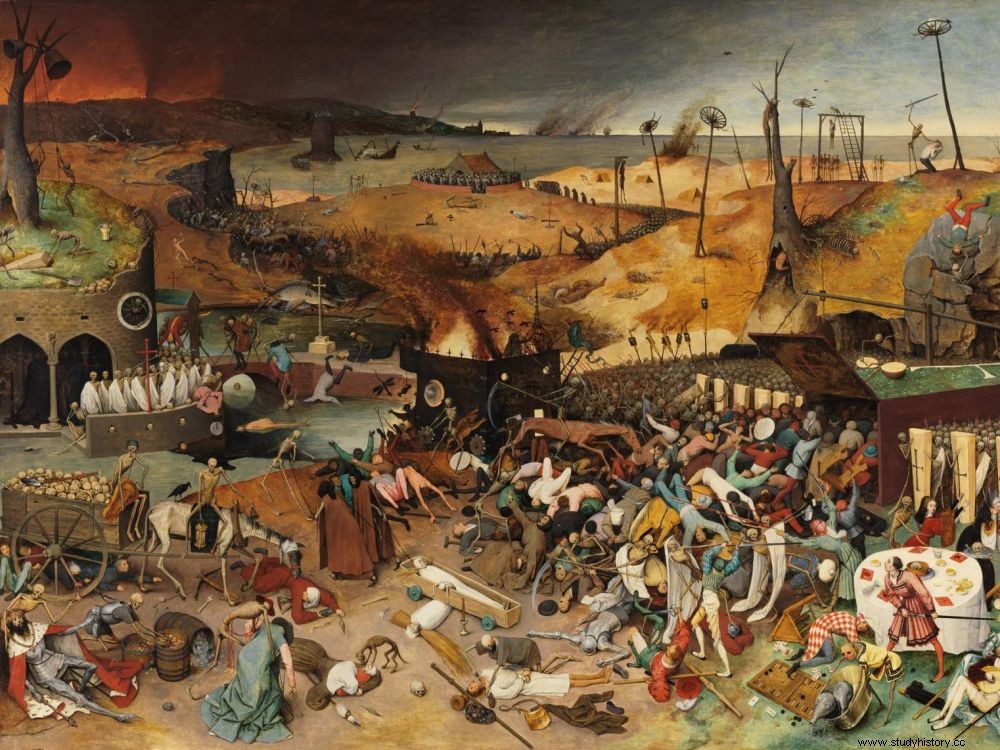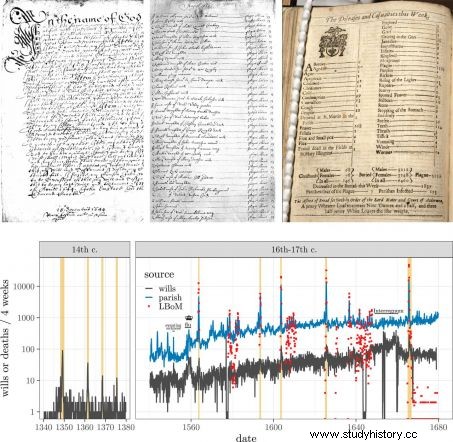One would think that after more than three centuries marked by waves of plague, between the start of the Black Death in 1348 and the Great Plague of 1665, Europeans would have learned to slow down the transmission of the disease. But a study proves the opposite extreme:in the 17th century, the plague would have spread four times faster.

"The Triumph of Death", a canvas created by Pieter Bruegel the Elder in 1562. Nearly a hundred years earlier, the Black Death would deeply mark the minds and the history of a continent that would live for several centuries at a morbid pace. plague waves.
We now know that plague, a disease caused by the bacillus Yersinia pestis , touched Man from Late Antiquity, marked in particular by the plague of Justinian in the second half of the 6th century. It may have been present much earlier, perhaps as early as the Bronze Age, but imprecise historical descriptions and the lack of paleopathological data do not allow us to say this with certainty. On the other hand, it is established without any doubt that the Black Death pandemic which struck Europe in 1348, brought back to the ports by infected ships, decimated more than a third of the population of the Old Continent and also raged in part of Europe. Asia and North Africa. It marked the beginning of what is known as the "second pandemic", which nevertheless designates a series of waves of epidemic rather than a single and intense period of circulation of the plague, which had spread over nearly five centuries.
London, a textbook case
Among the most affected areas is the city of London, which has experienced many, many years of resurgence of the disease – no less than 132, according to a study published in 2017 in Nature ("Trade Routes and Plague Transmission in Preindustrial Europe", P. H. Yu and Y. H. Wu). During each of the epidemics of the 17th century, 20% of its total population would have died. It is even estimated that the epidemic of 1348 killed 30% of its inhabitants. As a sustainable home, the English capital has thus been able to serve as a field of study for researchers from McMaster University, in Canada, to try to better understand the transmission mechanisms of the bacillus Yersinia pestis Through time.
After analyzing records covering more than three centuries of plague in London, a team led by David Earn, a professor in the Department of Mathematics and Statistics at McMaster, also a member of the Michael G. DeGroote Institute for Infectious Disease Research , made an interesting observation:in the British conurbation, the plague spread four times faster in the 17th century than in the 14th century. The results, published today in Proceedings of the National Academy of Sciences (PNAS) , indeed show a striking acceleration of its transmission between its appearance around 1348, the first wave which took away, as we said, 30 to 50% of Europeans, and the subsequent plague epidemics, the culmination of which was the Great Plague of 1665. By the 14th century, the number of infected people was doubling approximately every 43 days. In the 17th century, it doubled every 11 days.
A different mode of transmission?
We now know that plague, a disease caused by the bacillus Yersinia pestis , touched Man from Late Antiquity, marked in particular by the plague of Justinian in the second half of the 6th century. It may have been present much earlier, perhaps as early as the Bronze Age, but imprecise historical descriptions and the lack of paleopathological data do not allow us to say this with certainty. On the other hand, it is established without any doubt that the Black Death pandemic which struck Europe in 1348, brought back to the ports by infected ships, decimated more than a third of the population of the Old Continent and also raged in part of Europe. Asia and North Africa. It marked the beginning of what is known as the "second pandemic", which nevertheless designates a series of waves of epidemic rather than a single and intense period of circulation of the plague, which had spread over nearly five centuries.
London, a textbook case
Among the most affected areas is the city of London, which has experienced many, many years of resurgence of the disease – no less than 132, according to a study published in 2017 in Nature ("Trade Routes and Plague Transmission in Preindustrial Europe", P. H. Yu and Y. H. Wu). During each of the epidemics of the 17th century, 20% of its total population would have died. It is even estimated that the epidemic of 1348 killed 30% of its inhabitants. As a sustainable home, the English capital has thus been able to serve as a field of study for researchers from McMaster University, in Canada, to try to better understand the transmission mechanisms of the bacillus Yersinia pestis Through time.
After analyzing records covering more than three centuries of plague in London, a team led by David Earn, a professor in the Department of Mathematics and Statistics at McMaster, also a member of the Michael G. DeGroote Institute for Infectious Disease Research , made an interesting observation:in the British conurbation, the plague spread four times faster in the 17th century than in the 14th century. The results, published today in Proceedings of the National Academy of Sciences (PNAS) , indeed show a striking acceleration of its transmission between its appearance around 1348, the first wave which took away, as we said, 30 to 50% of Europeans, and the subsequent plague epidemics, the culmination of which was the Great Plague of 1665. By the 14th century, the number of infected people was doubling approximately every 43 days. In the 17th century, it doubled every 11 days.
A different mode of transmission?
If the researchers say they are "very surprised" For having discovered such a big difference between the growth rates of the first and the last epochs, they see an obvious reason:the mode of transmission must have been different according to the epochs. "Our article demonstrates that strictly pneumonic transmission is unlikely in the 14th century. However, we cannot exclude one mode of transmission more than another for the 17th century," assures David Earn to Sciences et Avenir .

A distinction is made between the so-called bubonic plague, which is transmitted indirectly by the bites of infected fleas, and pneumonic plague, which is spread by the respiratory tract. The team also hypothesizes that population density, living conditions and cooler temperatures could explain this acceleration, while ensuring that additional analyzes would be essential to confirm this. "Our main conclusion remains that the plague spread much faster three centuries after the first wave. It will be very interesting to try to understand why in the years to come" , continues the researcher.
Parish registers and wills
But how, at times when medicine and the art of archiving were still in their infancy, if not non-existent, was it possible to come to such a conclusion? "As we do not know the mode of transmission of the plague, for any of the documented outbreaks, we wondered what we could reliably estimate directly from death counts and wills" , says David Earn. Three sources were therefore used by the group of researchers, also composed of biologists and geneticists:the London Bills of mortality , weekly mortality statistics kept in London from 1592 to 1595 and then continuously from 1603, to monitor burials; parish registers, in which burials were recorded; and finally individual wills and testaments, which constitute a unique source before the end of the 16th century, when no count of the dead was kept.
"In those days, people typically wrote wills because they were dying or feared that they might die imminently. So we hypothesized that the dates of wills would be a good indicator of the spread of fear, and of death itself.For the 17th century, when wills and mortality were both recorded, we compared what we could deduce from each source, and found the same growth rates. I have hand-entered over 1,100 dates of 14th century wills, all of which have since been digitized and posted online."
As the Covid-19 pandemic continues to rage around the world, analyzing such epidemiological patterns from the past also provides insight into contemporary and future epidemics:"The same pathogen circulating in the same city at different times can spread at very different rates. It should be emphasized that any pathogen can cause epidemic growth rates depending on the different factors such as population density, social structure, environment or again the climate" , concludes David Earn.
